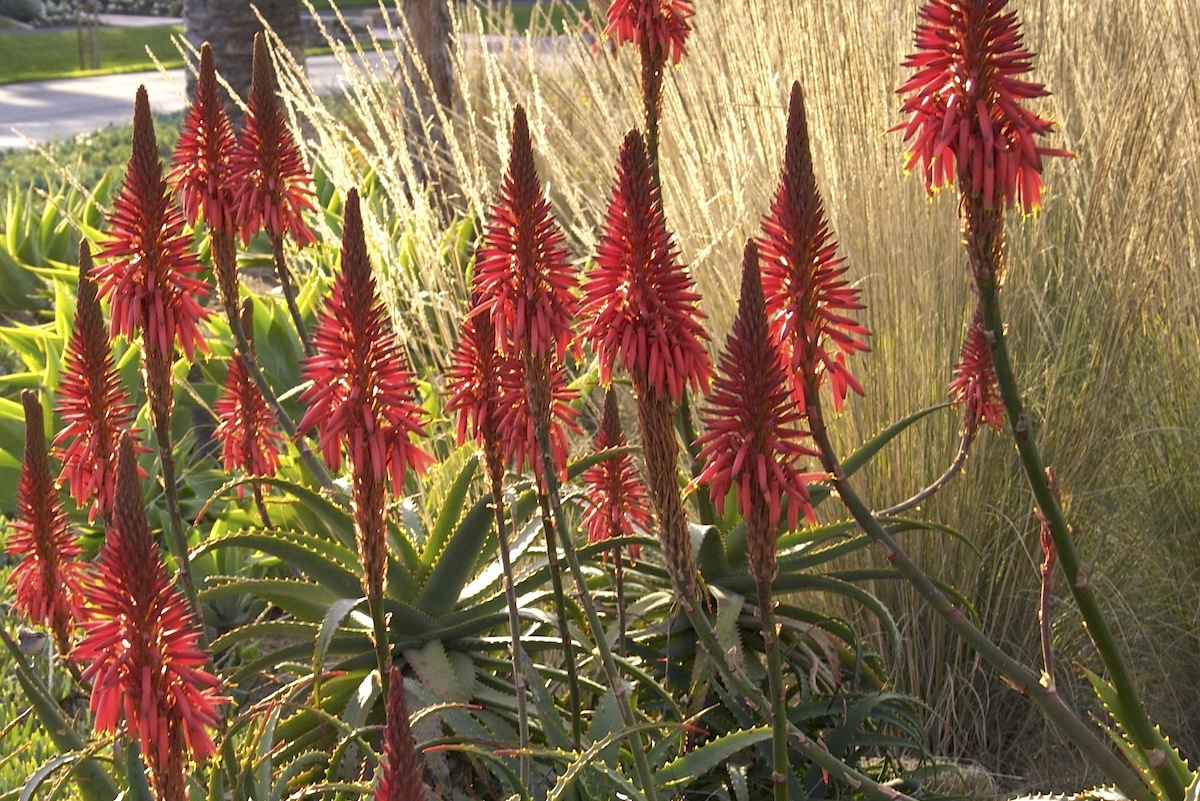
About Aloe arborescens (torch aloe)
One of the most widely grown succulents in California from the coast to the foothills is Aloe arborescens (torch aloe).
There’s no need to buy it. It’s so common, it’s a “pass-along plant,” meaning friendly neighbors who grow it will likely give you cuttings.
But before you go knocking on doors, here’s what you need to know to grow Aloe arborescens and keep it thriving.
Easy-care aloe
Aloe arborescens is from southeastern Africa from Mozambique to Cape Town---regions climactically similar to the Bay Area south.
This is one of the easiest landscape succulents. Aloe arborescens doesn’t get unmanageably large, although the species name means "treelike."
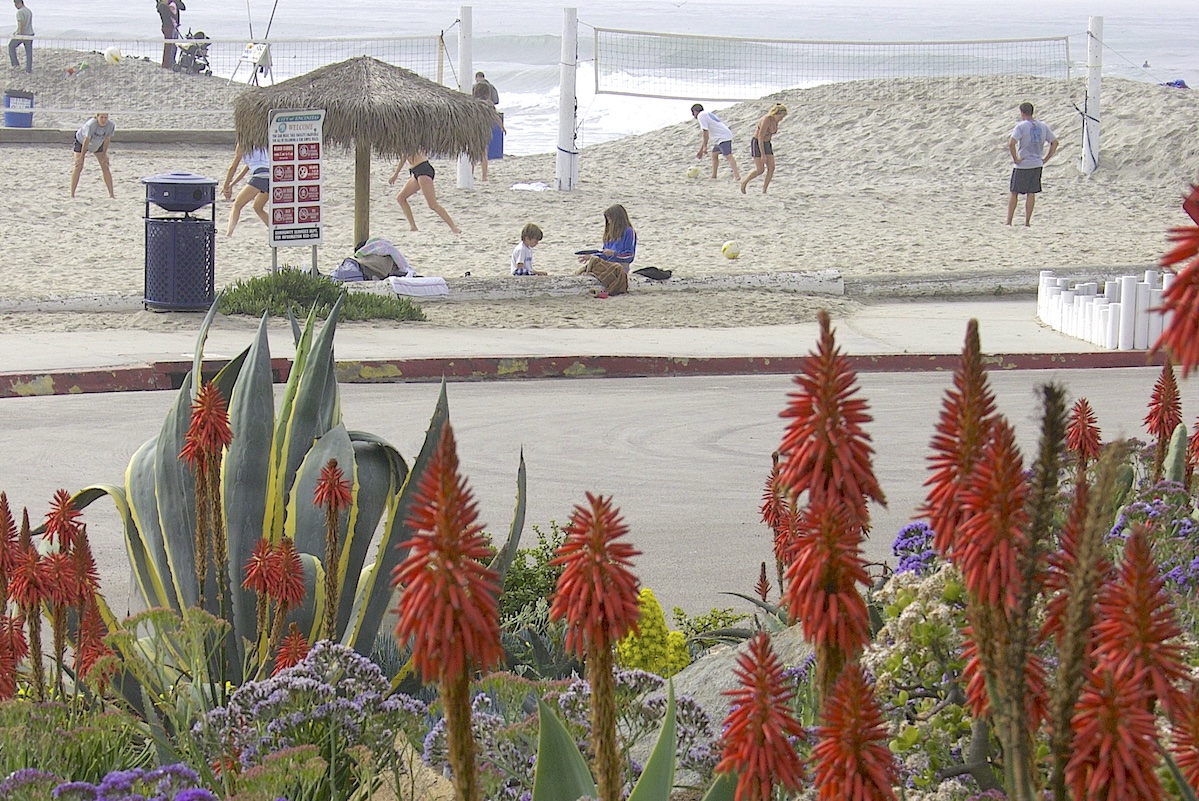
Beach garden with Aloe arborescens
It isn’t treelike at all. Rather, rosettes form a multi-headed colony over time, which can be as tall as 7 feet when in bloom. Such mounds are easy to whack back. Discard the cuttings, tuck them into garden gaps, or pass them along.
A beach-lover
These dramatic plants do fine exposed to salt spray.

Aloe arborescens in Laguna Beach, CA
I think of Aloe arborescens as "the Laguna Beach aloe," because it has naturalized along the cliff-top walkways of that city by the sea.
Those flowers!
Even as a child, I was fascinated by the flowers. Two-foot-tall coral-red spires of elongated, beadlike buds attract bees and hummingbirds.
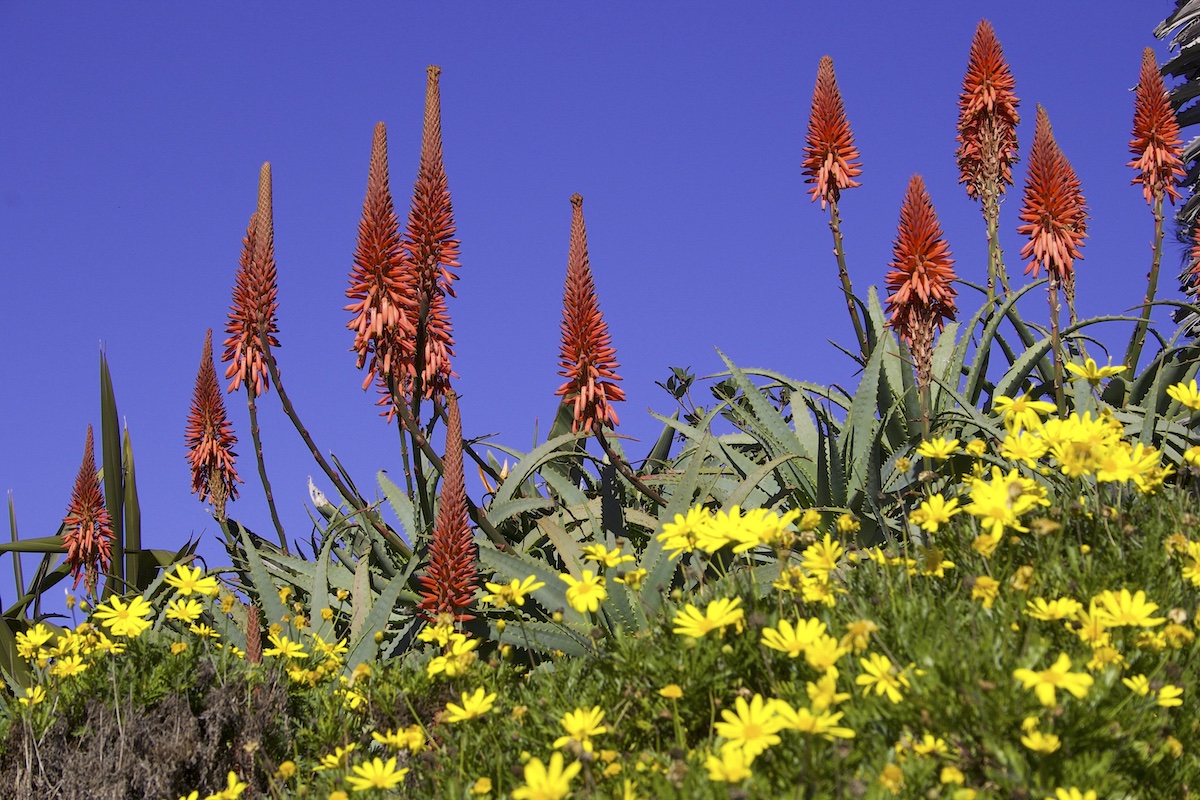
Aloe arborescens flowers contrast with blue sky and yellow euryops daisies
Against a blue sky, torch aloe flowers are unforgettable.
Best of all, like the majority of aloes, arborescens blooms midwinter, when little else is going on in the garden.
Gel and teeth
The gel is harmless but can stain clothing. Like its famous relative, Aloe vera, the gel of Aloe arborescens can be used medicinally, although I don’t recommend it. It’s a purgative, meaning it’ll cause cramping and rapidly clear out your digestive tract (!)
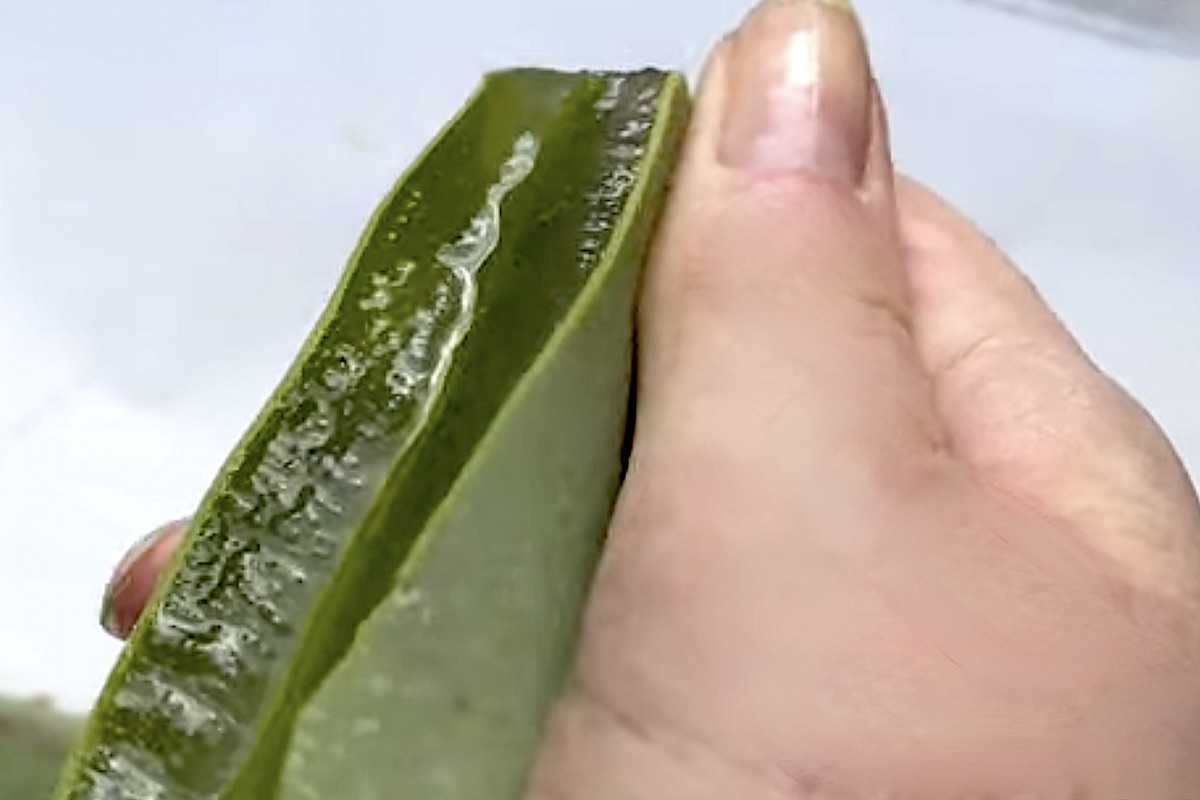
Aloe arborescens gel in a split-open leaf
Toothed edges of aloes look intimidating but are no more likely to draw blood than prickles of hardened wax...which they look and feel like.
Fire-retardance
Torch aloe's gel-filled leaves and tendency to form dense mounds make it an effective firebreak.
Several years ago I conducted an informal experiment (see my video, Do Succulents Burn?). I placed cuttings of various commonly-grown succulents from my garden onto a blazing fire. Without exception, they charred but didn't catch fire nor did they transmit it. Basically, the plants cooked.
Succulents' high moisture content makes them significantly more fire-retardant than thin-leaved, woody plants. Learn more (and see how Aloe arborescens may have "saved” a house from burning) on this site.
How to start cuttings
Aloe arborescens starts readily from cuttings. Slice the stem about a foot below the top of a rosette. Dig a hole big enough to hold the stem upright, insert it, and firm the soil around it. In a few weeks, roots will grow and anchor the plant.
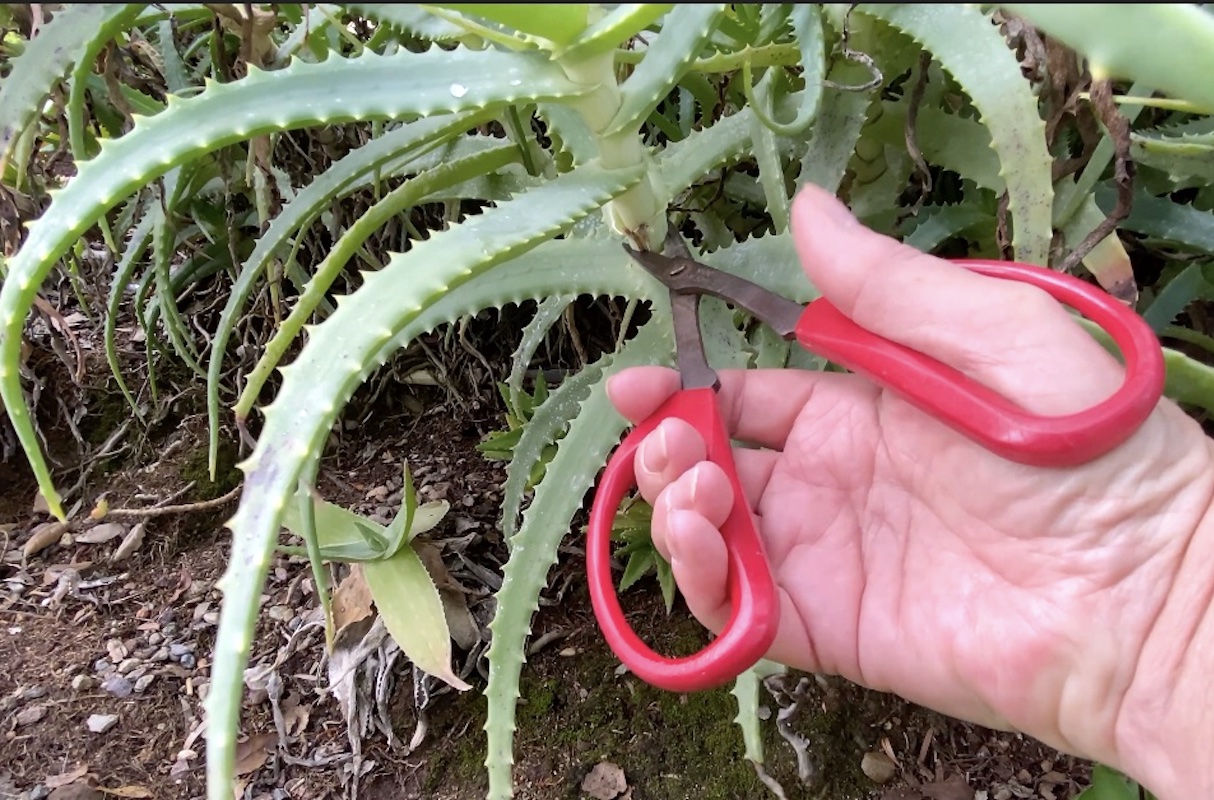
In the video, I demonstrate taking a cutting. This one came from the outer, lower part of the mound.
Succulent cuttings can't grow without roots, but they won’t die without them either. At least, not for a long time. Cuttings of aloes are typical; they live off the moisture in their leaves---which btw is the definition of a succulent.
Soil, water, fertilizer
In a mild climate, an established colony of Aloe arborescens can get by on rainfall. However, the plants will be more lush and healthier if hosed every few weeks in summer and fall.
Aloe arborescens doesn’t require rich soil, as long as it’s well draining. Nor does it need fertilizing or irrigation. But it doesn’t mind them either, in fact, it grows more vigorously when pampered.
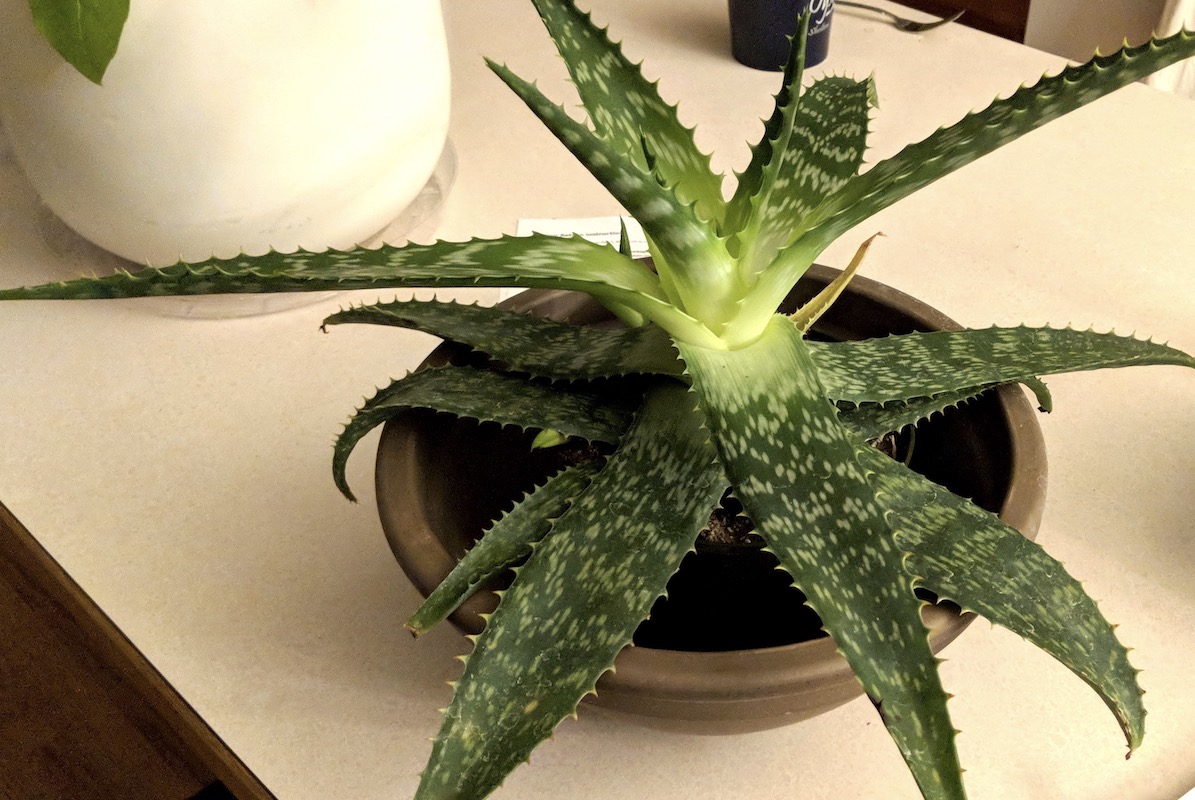
An aloe indoors with inadequate light
Aloes---most plants for that matter---need sunshine in order to bloom and photosynthesize. They tend to sulk as houseplants, flattening their leaves to expose maximum surface area to available light.
Sun and heat
Along the coast, Aloe arborescens wants all-day sun; farther inland, some protection from scorching afternoon sun in summer and frosty nights below 25 degrees F in winter.
You won’t see Aloe arborescens in Arizona, except perhaps in dappled shade, because desert sun and heat are too strong for it.
Varieties
Alhough most often green-leaved and orange-flowered, Aloe arborescens has sub-varieties that collectors consider cool.
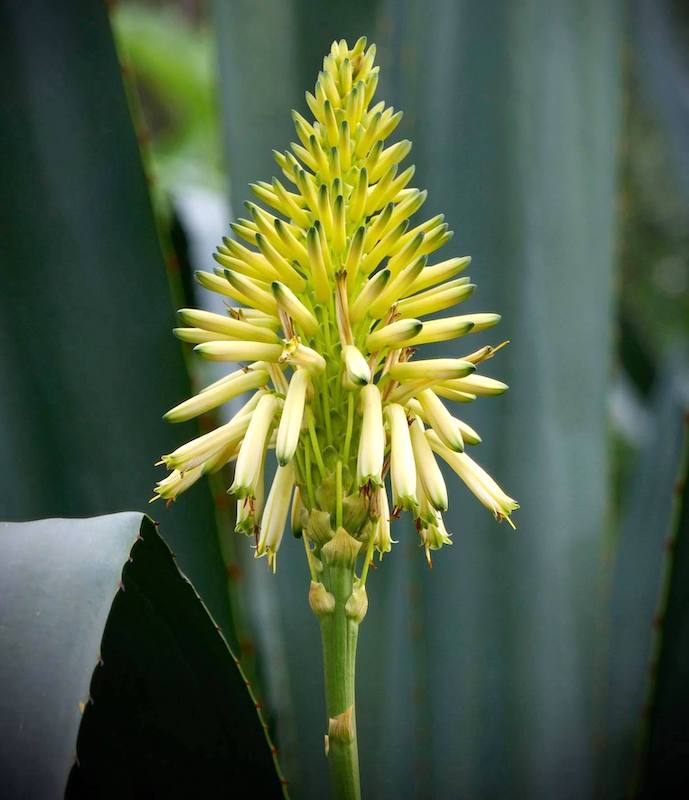
Aloe arborescens 'Lutea'
For example, Aloe arborescens ‘Lutea’ has yellow flowers; and leaves of Aloe arborescens ‘Variegata’ (my favorite) are striped green-and-cream.

Isn't Aloe arborescens 'Variegata' gorgeous?
Pests and problems
The biggest concern with aloes, regardless of species or variety, is a microscopic mite that infests the tissues. It causes cancer-like growth that resembles tree burls.

Aloe arborescens 'Variegata' exhibiting aloe mite
Such growths have an intriguing weirdness, but please do us all a favor and remove them to keep the mite from spreading.

Aloe flowers distorted by aloe mite
Remove deformed flowers as well, because mites travel on air currents. And don’t pass along cuttings of infested plants. Once an aloe has the mite, it always has it.
The only other problem I’ve encountered during decades of growing Aloe arborescens in my Zone 9b garden northeast of San Diego, was that after a particularly rainy winter, numerous leaves had dark, pitted spots.
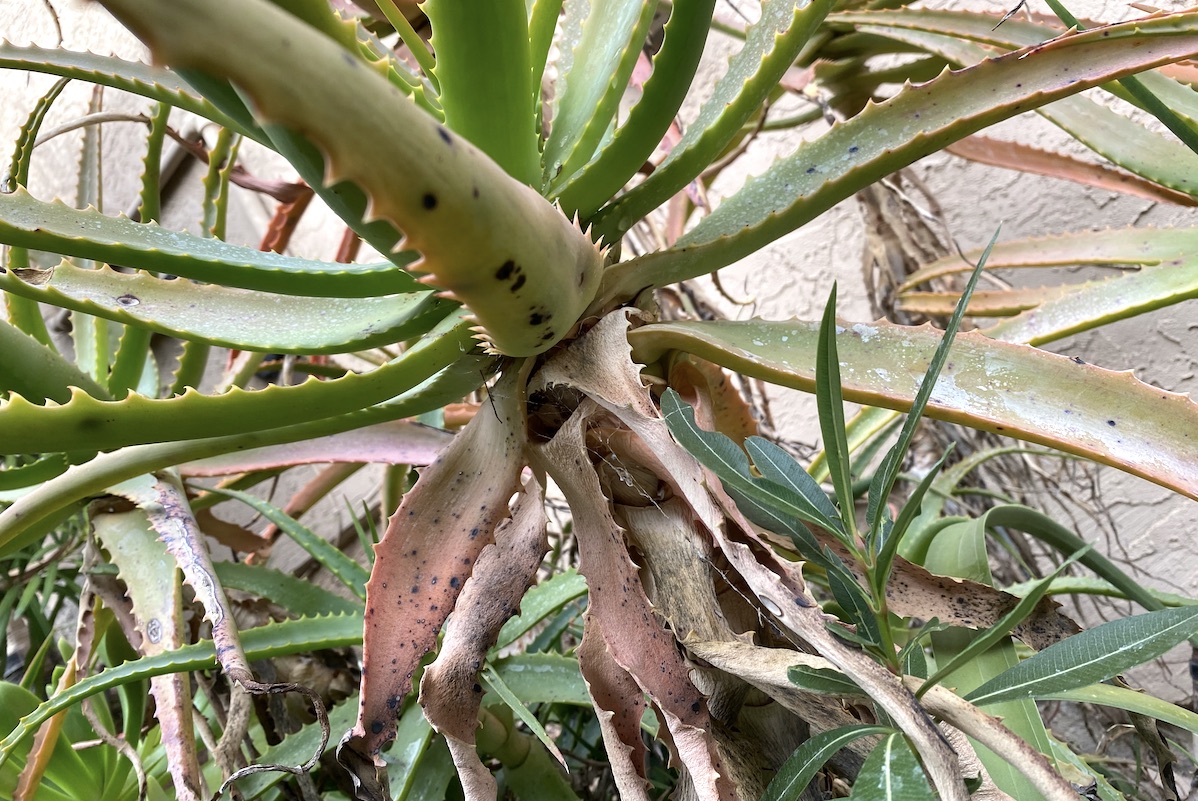
Black pitted areas on leaves indicate a fungal disease
I cut the plants back to healthy growth, discarded anything diseased, drenched stems and remaining leaves with copper fungicide, and in six months the plants grew back better than ever.
Questions?
If you love aloes---and Aloe arborescens in particular---and have observations to share or questions to ask, by all means do so below in the Comments or on my corresponding YouTube video.
I look forward to hearing from you!
Related Info on this site
Aloes: Uses, Photos, IDs & Varieties
Aloes: How To Grow & Varieties All about aloes plus a photo gallery of aloes ID’d and in bloom See All Succulent Types Aeonium Agaves Aloes Cactus Crassula Echeveria Euphorbias Ice Plants Kalanchoe Portulacaria Senecio About Aloes There are dozens of species of Aloe, from tall trees to dwarf cultivars. Aloes typically have juicy, triangular leaves…
Which Aloes Are Best for Your Garden?
One of Southern CA’s in-demand landscape designers, Bill Schnetz of Schnetz Landscape, Inc., likes to use aloes of all sizes in residential gardens. If you love succulents, live in a mild climate, and grow these South Africans in soil that drains well, “they’ll soon become your favorite plants,” Bills says. For a natural setting, he suggests…
Midwinter Succulent Show: Big Aloes In Bloom
Above: Aloe ferox at Desert Theater nursery, Escondido, CA. From my video, Spectacular Aloes in Flower. Large, sculptural aloes with brilliant, Popsicle-like flowers make striking garden plants. Midwinter is peak aloe bloom season and an excellent time to see them in nurseries and landscapes. Aloe ferox, or Cape Aloe, might be considered a tree because of its height at maturity–6 to 8 feet with bloom…




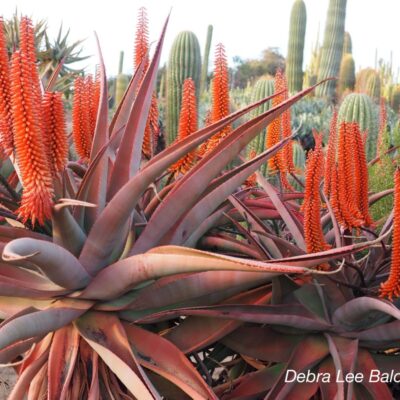
Hello Debra
While reading your article I was thrilled to find the answer to something that was concerning me about my spiral aloe.
I purchased it 2nd hand and it had not been well cared for, was totally waterlogged and rotting in the stem. So I trimmed it up, cut out the rot, and have had it in a pot drying out for some months. Recently though, while it looks to have rooted well, it flattened out and started to go a bit pale at the base of the leaves. Now reading your article above, I realise it needs more light! So I’ve moved it into another location and am covering it with shade cloth after a period in the sun to stop it being over exposed.
I’m hoping to plant it out on a slope in a rock garden at some point in the future. Spiral aloes are quite hard to come by in New Zealand, so I want to make sure it survives.
Best wishes and thank you!
Bridget
Hi Bridget — I agree with you—excise the rot, give it more sun, and protect with shade cloth as it acclimates to full sun. You might want to run it all by expert Alan Beverly. Spiral aloes are fiddly, and this is a highly valued and important specimen. LMK how it does!
I have a very large Torch Aloe plant (approximately 8 feet in diameter and annually produces close to 100 blooms. Some of the blooms (about 10%) have a round mass at the end of the bloom which appears green and gradually turns a black color. At first, I thought that these may be seed pods, but after watching your video about the species, I am concerned that the plant may have mites and wonder what a course of action would be. I would hate to remove the plant.
Hi Mark — No need to take drastic action. It may indeed be the mite, but if you can reach those little balls, you can diminish the mite population and its ability to spread by snipping and removing them. Or be more aggressive and remove the flowers where they emerge from the plants.
The mite is simply a reality, and I suppose I’ll get flack for not telling you to remove the whole shebang, but is it’s a lovely enhancement to your garden and the mite’s going to spread regardless.
Hello again, Debra . . .
Many thanks for your response. Back in the 1980s, my late father planted a small cutting given to him by a neighbor, just as you have mentioned.
I now know that these are NOT seed pods and I will take action to remove those flowers which have been affected by the mites.
I do have another question, unrelated to mites . . . my father planted a second identical plant near the one affected by mites; the second plant blooms within days after the other completes its annual bloom cycle and this occurs annually without fail.
I have taken cuttings from both plants and all the cuttings bloom at the same time as their respective mother plants . . . I have never seen a plant’s cuttings mimic the bloom cycle so closely. Your thoughts?
Best!
Mark
Interesting. The only thing I can think of is the “second identical plant” and its descendants get less sun than their cousins. But you said they’re nearby, so I’m afraid IHNI (I have no idea).
Hi Debra, the original Aloe Arborescens with the red flower is there a hybrid version of this with red flower and if so is there any way to tell them apart as I require the original kind? Thank you for your time. I am in Australia. Have a wonderful day. Cheers